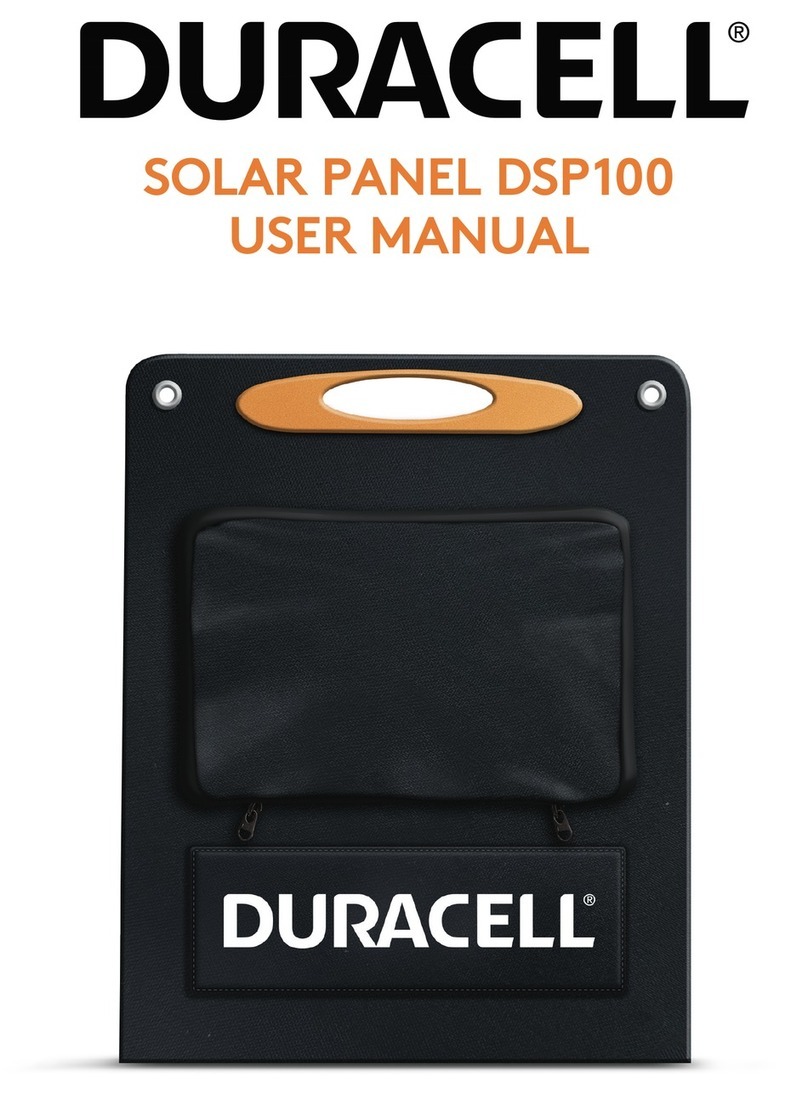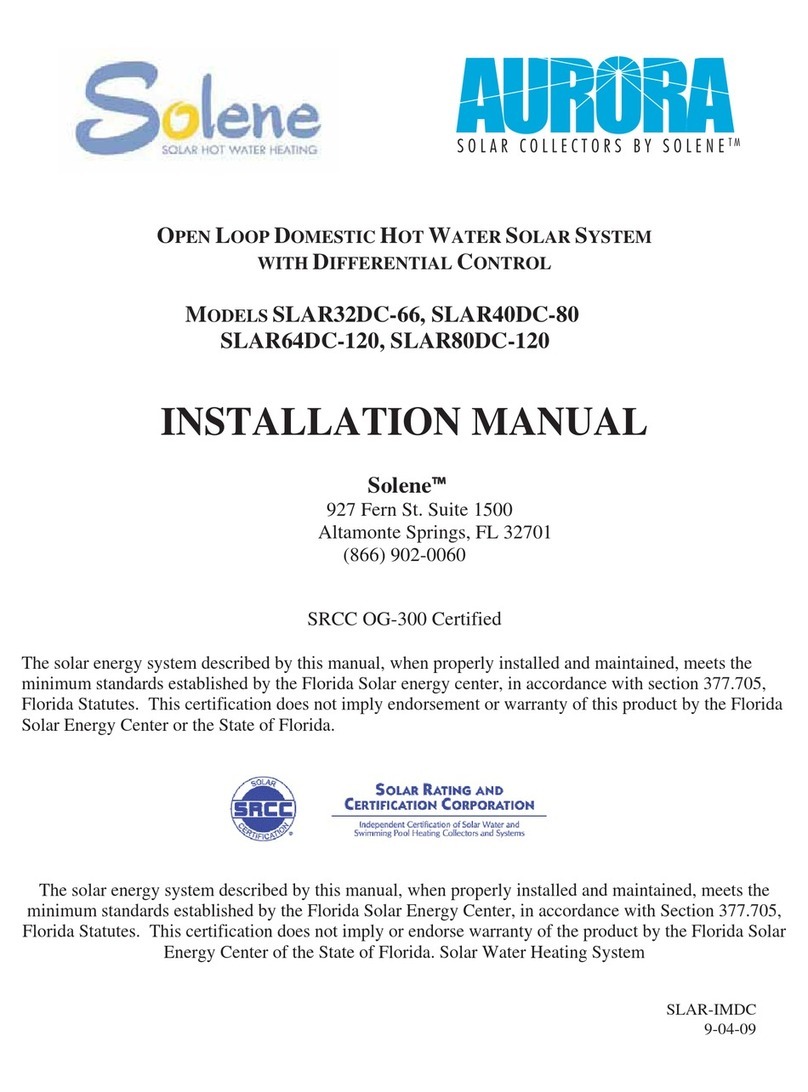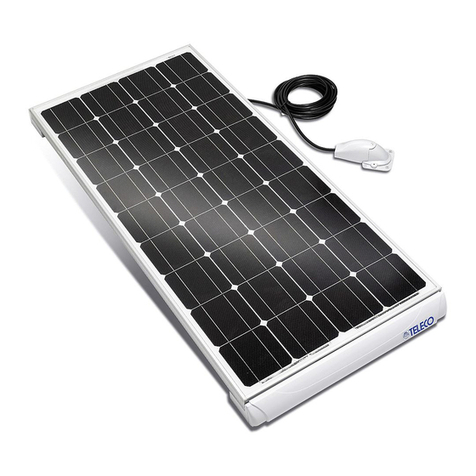Solex solar roofing User manual

Solex Roofing Installation Manual
Revised 9th February 2010
Subject to ongoing revision – latest copy available online
© Solex Energy Ltd 2009

Solex Roofing Installation Manual 1
Solex Energy Ltd +44(0)1305 837223 www.solexenergy.co.uk
Contents
Page Page
Overview 2 Plumbing Installation
Operation summary 2 - Basic system 27
Roof orientation and pitch 2 - Hot water systems 31
Performance 2 - Space heating & hot water 33
System sizing 2 - Pool heating 34
Design and Layout 3 - Thermal stores 34
Planning considerations (UK) 3 - Retrofit coils 37
Choice of products 4 - Multiple roofs 38
Installation skills 4
Tools 5 Electrical Installation
Materials delivery and handling 5 - Controller types 38
Sitework – info for main contractor 6 - Controller wiring 39
Health and safety considerations 7 - Pump & valve wiring 39
- Sensor wiring 39
Roof installation – Solar slates - Wiring for pumped circuits 40
- Roof construction 8 - Controller programming 40
- Absorbers 10
- Slates 13 Maintenance
-- Whole roof 14 - Roof maintenance 41
-- Patch 16 - Annual maintenance 42
-- Strip 16
- Specifications 17
Roof installation – Nu-lok slates
- Roof construction 19
- Absorbers 21
- Nu-lok battens 23
- Slates 24
-- Whole roof 24
-- Patch 25
-- Strip 25
- Specifications 26

Solex Roofing Installation Manual 2
Solex Energy Ltd +44(0)1305 837223 www.solexenergy.co.uk
Overview
Solar roofing offers an alternative to solar traditional solar thermal panels or tubes. Its
main advantages are those of cost, aesthetics, and the ability to provide larger solar
collecting areas on a given roof slope. The efficiency per m2is around 80% that of
traditional flat panels.
The output of the solar roofing is heated water, which may be used for hot water, space
heating, pool heating or any other water heating application.
Operation Summary
A solar fluid circulates through black silicone rubber absorber strips on the roof and is
heated by the sun. Solar glazing in the form of glass or plastic slates, tiles or sheets
covers and insulates these strips, and forms the roof surface. An insulation layer behind
the strips also reduces heat loss.
The rubber will cope with freezing conditions, and in overheat situations the fluid will drop
back into a holding tank below. The fluid is circulated by a solar pump/controller unit which
transfers the heat through pipes to where it is required.
Roof Orientation and Pitch
•The roof to be covered should ideally face south.
•Orientations from SE to SW are fine with performance around -12% at the extremes.
•Orientations as far as E or W still perform okay, with performance at around -25%.
Given the choice, and all other considerations being equal, W or SW should be chosen
over E or SE, as ambient temperatures are higher in the afternoon increasing
performance, and also hot water and heating demand is usually higher in the evening.
The ideal pitch is 30oto 50ofor year round performance. Steeper pitches up to 60ofavour
winter performance which is important for space heating. The slates have a minimum
pitch of 25o and a maximum of 90o. For pitches under 25oor over 70ocontact us for
additional installation instructions.
Performance
The average annual output (south facing, 30o-50o) is in the range 400 - 425kwh/m2/annum
when used to provide hot water, and somewhat more than this when used to provide lower
temperature output e.g. for space and pool heating. Instantaneous output under full sun is
up to 720w/m2.
Use the spreadsheet at www.solexenergy.co.uk to calculate roof outputs, energy savings
and system costs.
System Sizing
•Hot water systems – the recommended sizing is 2m2solar roof/person, with a
minimum size of 6m2. The recommended sizing is generally:
Typical 3 bedroom house – 8m2
Typical 4 bedroom house – 10m2
Typical 5 bedroom house – 12m2

Solex Roofing Installation Manual 3
Solex Energy Ltd +44(0)1305 837223 www.solexenergy.co.uk
•Space heating systems – with underfloor heating the recommended minimum size is
at least half the floor area in solar roofing, although ideally the solar roof will be at least
equal in area to the heated floor area.
•Pool heating systems – the recommended size is 60% of the pool area in solar
roofing for outdoor pools, and 85% of the pool area for indoor pools (on the assumption
that indoor pools are used all year.)
•Combined systems – the recommended size is generally the larger of any of the
individual parts of the system. E.g. for water and space heating systems, the system is
sized to the space heating requirements.
Design and Layout
Solar roofing may be installed
•To the extremities of the roof, or
•As a patch surrounded by a
compatible roofing material, or
•As a strip between other non
compatible roofing materials.
The visual effect of the solar roofing is a combination of the reflection from the surface, and
the black colour of the absorbers beneath. Overall a uniform medium to light grey is
observed which changes depending on weather conditions.
Planning Permission (UK)
1. Retrofit to dwelling house – applies to:
•All buildings except I, II* and II listed buildings,
•All areas except some conservation areas where specific permitted development
rights have been removed by the LPA,
Installing solar roofing is considered permitted development and so does not require
planning permission – GPDO, Schedule2, Part1, Class C
2. Retrofit to dwelling house – applies to:
•All buildings except I, II* and II listed buildings,
•Conservation areas where specific permitted development rights have been
removed by the LPA under GPDO Section 4.2
Installing solar roofing is permitted unless it is to a roof slope which fronts a highway,
waterway or open space (‘relevant location’). – GPDO Section 4.2
3. Listed buildings
Apply for listed building consent, and planning permission if situation 2 above applies
and the roof fronts a relevant location.
4. New build houses / extensions
Submit details of the solar roofing materials with the planning application. Bring the
above permitted development rights to the attention of the LPA if they are minded not
to approve this type of material.

Solex Roofing Installation Manual 4
Solex Energy Ltd +44(0)1305 837223 www.solexenergy.co.uk
5. Agricultural and forestry buildings
Installing solar roofing is considered permitted development and so does not require
planning permission – GPDO, Schedule2, Parts 6 & 7
6. Industrial and warehouse buildings
Installing solar roofing is considered permitted development and so does not require
planning permission – GPDO, Schedule2, Part 8
Choice of products
We make a range of different types of solar roofing to suit various applications:
Solar Slates
These are glass traditional style double lap solar slates, which
are compatible with traditional 500 and 600mm (20” and 24”) size
slates. They are installed onto a normal felted and battened roof
structure.
Nu-lok Slates
These are glass single lap slates with a unique easy to fit metal
battening system. The glass slates are compatible with Nu-Lok
heavy-duty ceramic and natural slates, and also with PV slates.
This is an easy to fit, low labour requirement system.
Solar Tiles
These polycarbonate single lap tiles are compatible with Marley
Modern/Redland Mini-stonewold concrete tiles. They are ideal for
fitting into an existing concrete tiled roof.
Solar Cladding
This is a lightweight solar cladding system for use over existing
profile metal roofing. Ideal for industrial applications, it utilises
existing profile roof insulation for low imposed weight, low cost,
high output systems.
Installation Skills
The system may be fitted by M&E contractors and roofers working together
•Generally an M&E qualified person should oversee the whole installation
•The battens, insulation, rubber absorber, EPDM membrane may be installed by
roofers, under the guidance of M&E
•The manifolds, supply pipes, roof sensor and joints in the absorber by M&E
•Installation of the tiles/slates by the roofers
•Installation of the internal system components by M&E
•Electrical installation of the controller, pump and motorised valves (where
applicable) by M&E / qualified electrician

Solex Roofing Installation Manual 5
Solex Energy Ltd +44(0)1305 837223 www.solexenergy.co.uk
Tools
Required in addition to normal roofing tools:
•Scissors for cutting the absorber strip (not a knife)
•Staple gun / hand tacker for fixing the absorber strip and EPDM
•Crimping pliers (supplied) for the absorber pipe clips
•Silicone oil (supplied) for lubricating absorber joiners and manifolds
•First fix type nail gun and hardened nails (Nu-lok systems only)
•Cordless driver and Pozidrive bits for slate clip screws (solar slate systems only)
•Pump / compressor and fittings for pressure testing
Materials – Calculating Quantities
Quantities may be worked out manually, or calculated using our roof calculator
spreadsheet at www.solexenergy.co.uk. This program also outputs a roof specification
page which may be useful for the roofers as it summarises key dimensions and figures.
Materials – Delivery and Storage
Solar roof materials and components are usually delivered on a pallet. Provisions must be
made for handling this on-site. The delivery driver may have tail lift (if requested) and
pallet truck, so the pallet may be moved as far as the concrete or tarmac surface will allow.
A delivery note will be included with the consignment, and the materials should be checked
against this as soon as practical, and in any event within 2 working days of delivery. Any
shortages or damage must be notified within 2 working days of delivery.
Thermal stores are either delivered from stock via a pallet carrier, or direct from the
manufacturer. When delivered direct from the manufacturer, the lorry will have no
offloading facilities unless requested, and the store must either be forklifted off, or craned
off. There is a lifting eye provided in the packaging, which screws into the central top port.
When on a level surface stores may be easily moved with a pallet truck. The label on
thermal stores must be checked on delivery, to ensure that the correct model has been
supplied.
Solar roof components should be protected from the weather before installation. If packets
of solar slates become wet the packaging will disintegrate, with the possibility of resulting
damage and health and safety issues from falling slates when being handled. Packets or
loose stacks of solar slates which become wet will draw in water causing them to stick
together. They may be parted using the end of a slate clip or any similar flat object which
does not damage the slate edge.
Wetting of the insulation should be avoided if possible, although it will not be damaged by
wetting. If exposed to the weather on the roof before slating, most water will drain out
down the membrane, and the remainder will evaporate when the roof is watertight.

Solex Roofing Installation Manual 6
Solex Energy Ltd +44(0)1305 837223 www.solexenergy.co.uk
Sitework – Information for Site Foreman / Main Contractors
Some of the key points regarding the installation:
•The solar roof requires both vertical counterbattens, and horizontal battens (25 x 50)
•The vertical counterbattens must be laid over the breather membrane
•Insulation is laid between the counterbattens before nailing the horizontal battens
•Special attention must be paid to the eaves detail where the solar slates start at the
eaves – see relevant diagram
•Solex or our contractors do not supply batten – this must be provided on-site
•When Solex or our contractors arrive on-site we expect the roof to be complete to the
membrane and counterbatten stage (i.e. watertight)
•Absorbers must be pressure tested with air before and during fitting the slates/tiles
•Ridges and hips may be wet or dry fitted against the solar slates, and are usually
installed when finishing the conventional roofing, after the solar roof has been finished
•Mortared ridges/hips sometimes leach lime or salts which stain the glass. This may be
removed with dilute hydrochloric acid, although it will weather off within 6 months
•The system requires pipes (generally 2x 22mm for systems <70m2) and a cable
(generally 1x 2 core) running to the roof
•The system requires a vented expansion tank (supplied by Solex) located at least
500mm below the level of the bottom of the solar roof, and not more than 4m from the
top of the solar roof. Brackets are available for wall mounting.
•Sizing is usually as follows:
•The expansion tank requires a cold fill supply, an overflow and must be accessible for
maintenance
•Thermal stores, where supplied, are generally large, so provisions must be made for
handling (see delivery information above)
•Consideration must be given to access arrangements for thermal stores, and weight
loadings of floors (they stand on three metal feet). See the thermal store specifications
toward end of this guide.
•Thermal stores (1.5 bar) require a feed & expansion tank (not supplied by Solex). 3.0
bar stores may also be installed as a pressurised system subject to meeting
regulations.
Roof area L W H Kg
up to 8m2350 270 370 35
up to 25m2600 300 450 80
up to 40m21100 290 460 135
up to 70m21100 290 620 185
up to 85m2920 420 630 220
up to 115m21100 320 825 265
up to 200m21250 360 1010 420

Solex Roofing Installation Manual 7
Solex Energy Ltd +44(0)1305 837223 www.solexenergy.co.uk
Health and Safety Considerations
These are given in addition to all other health and safety guidelines and regulations
relevant to roofing, plumbing and general site work, which the tradesmen involved should
already be aware of.
•Boxes of glass slates are heavy, ranging in weight up to 40kg per pack. Suitable
handling practices should be adopted. If possible they should be lifted to the
scaffold with a forklift.
•Slate boxes which have become wet may disintegrate leading to the possibility of
sliding and/or falling slates
•Where glass slates are being handled there is the possibility of breakage, resulting
in numerous small glass fragments. If this happens gloves must be worn during
cleaning up, which is best done using a dustpan and brush.
•When stacking loose slates vertically against an object, e.g. scaffolding, the edge of
the first one should be protected with something soft.
•When stacking loose slates horizontally ensure that no dirt or fragments are trapped
between sheets which may cause damage. Slates stacked loose horizontally are
liable to slide sideways off the stack without warning, causing damage and hazards.
•Rubber absorber strips are supplied on large rolls which may weigh over 25kg.
Suitable handling practices should be adopted.
•Legionella – water stored in hot water cylinders between 20oC and 45oC may breed
legionella bacteria. Provision must be made to prevent this, for example by heating
the entire cylinder to above 60oC at least once a week.
Vermin
The silicone absorber strip and supply pipes are susceptible to attack by vermin.
Adequate precautions should be taken to ensure vermin, especially mice, are not able to
access the roof between the breather membrane and slates/tiles.

Solex Roofing Installation Manual 8
Solex Energy Ltd +44(0)1305 837223 www.solexenergy.co.uk
Roof Installation – Solar slates
The roof takes up a thickness of approx 70mm from the membrane upwards. The roof
loading at 34kg/m2is similar to that for natural or artificial slates. The construction
employed is conventional counterbattens and battens:
Alternative eaves arrangement:

Solex Roofing Installation Manual 9
Solex Energy Ltd +44(0)1305 837223 www.solexenergy.co.uk
The roof is built up as follows:
1. Rafters – for complete eaves to ridge installation of solar
slates the rafters should be of length (c x g)+50-f where c =
number of courses, g = batten gauge between centres, and f =
facia board thickness
2. Membrane – a breather membrane should be used, laid
across any of the following roof constructions:
•Rafters, or
•Rafters with insulation between, or
•Insulation sarking boards, or
•Timber sarking boards.
The breather membrane MUST be laid correctly to form a
waterproof layer which will drain water to the eaves without
pooling. In the event of any damage occurring to the
absorber at any time, this breather membrane will ensure
that no water enters the building.
3. Facia and eaves – where the solar slates go right to the
eaves one of the arrangements shown in the diagrams above
should be suitable. A tilting fillet or ply may be used, but
plastic eaves carriers will melt in the heat under the glass tiles.
The membrane can also be dressed down behind the facia,
although care must be taken over the fate of water running
behind the facia. (picture – eaves before installation of facia)
4. Counterbattens – 25mm thick counterbattens must be used.
These must go on top of the membrane, and start from under
the second batten as shown above.
5. Insulation – 25mm mineral fibre batts are cut to fit snugly
between the counterbattens, over the whole roof except the
far left and far right ‘channels’ between the counterbattens,
which are left open to allow space for the absorber loops,
manifolds and pipes.
The easiest way to cut the batts is to place one against a
counterbatten, and cut down with a knife using the opposite
counterbatten as a guide. Use a blunt tipped knife to avoid
damaging the membrane.
Wetting of the insulation should be avoided if possible,
although it will not be damaged by water. If exposed to the
weather most water will drain out down the membrane, and
the remainder will evaporate when the roof is watertight.
Note that the insulation supplied is the minimum
recommended for the system. Extra insulation, especially in
the form of foam insulation boards over the rafters, will
increase the efficiency of the system.

Solex Roofing Installation Manual 10
Solex Energy Ltd +44(0)1305 837223 www.solexenergy.co.uk
6. EPDM – the left and right channels are covered with an EPDM
membrane, which is stapled to the counterbattens and
dressed neatly into the channel. This has three purposes – it
protects the breather membrane from UV, it prevents the
colour of the membrane from showing through the slates, and
in the unlikely event of a leak from a manifold or pipe it offers
added protection to the building. The EPDM must therefore
be dressed over the eaves to allow run off.
The EPDM should also be used to cover any roof membrane,
insulation, battens etc. which will show through the glass tiles
if left uncovered.
7. Battens – 25mm x 50mm battens are used, which should be
treated or naturally durable, e.g. western red cedar. The
batten spacing can be in the range:
•500 series 200 - 212mm between centres
•600 series 250 - 262mm between centres
If the solar slate area starts at the eaves the eaves batten
must be 10mm thicker – 35mm. A bigger kick-up is possible
up to +25mm, but not recommended (50 or 60mm screws for
the slate clips may be required).
Note that as the glass slates cannot be cut, the battens for the
eaves course must be spaced the same as for the subsequent
courses. The only exception is where longer eaves clips are
used for a larger gutter overhang, when the first two battens
may be closer together. The space between the first two
battens must be kept clear for the absorber strip. Similarly,
the battens should be gauged out so that there is a complete
course at the ridge.
The absorber strips will loop under the battens at the ends, so
small sections of batten should be left out to allow this, which
may be nailed in after the installation of the absorber. The
omitted sections will generally be on every other course,
although the route of the absorber should be planned before
the battening process and the battens installed to suit.
8. Absorber strips, supply – these are supplied on 25m rolls.
For longer lengths joiner kits are supplied, consisting of short
pipe segments and O clips.
The roof calculator spreadsheet will output the length of
absorber required. Alternatively, it may be necessary to work
it out manually – the length of the course where the absorber
will lay is measured, and the loop factor is added for every
end of course – 500 series loop=120mm / 600 series
loop=150mm. The usual measuring points are the outer
edges of the EPDM covered channels detailed above.

Solex Roofing Installation Manual 11
Solex Energy Ltd +44(0)1305 837223 www.solexenergy.co.uk
Where the roof is sufficiently large, it is necessary to divide it
into parallel absorber circuits, which should be as close to
equal lengths as possible. For example a roof of 15 courses
may be divided into three courses of 5, or a roof of 12 courses
may be divided into circuits of 6, 4, 3 or exceptionally 2
courses depending on the overall length of the roof and
therefore the length of absorber strip in each circuit.
The Roof Calculator will give some guidance, although
generally we recommend that each circuit does not exceed
40m in length, which equates to around 8m2of 500 series
roofing or 10m2of 600 series roofing. There is no minimum
length of circuits, although having many smaller circuits will
result in more manifolds and connections.
9. Absorber strips, installation – when installing the rubber
absorber, it is advisable to start at the top of the roof, so that
there is less foot traffic on the installed rubber.
Starting at the end where the top manifold is required, the
absorber is unrolled along the batten with the flange at the
top. The flange is positioned to cover the batten and staple
gunned to it at 300mm intervals. Standard staples may be
used, as the absorber will be held in place by slate fixings
which pierce the flange.
At the end of the course, in the channel where the EPDM has
been positioned, the absorber is folded back on itself, still
keeping the flange at the top. The individual tubes are then
split away from each other so that each tube follows a natural
curve down to the second course.
When splitting the tubes apart, great care must be taken not to
damage the surface of any of the tubes. A pair of scissors
(not a Stanley knife) should be used. The point of the scissors
is pushed through all the tear lines of the strip, and the tubes
pulled apart in both directions as far as necessary. This
should be done with care, as sometimes the split can start to
run off toward a tube wall. If this happens, use the scissors
again to re-start the tear.
The tubes should be arranged neatly so that there are no
kinks which could disrupt the flow of water. The redundant
centre and bottom strips may get in the way and can be
removed at this point if desired. The top flange should be cut
at its midpoint and stapled along the battens, extending if
necessary with some spare flange which is supplied.
The absorber is then run out along the next course and fixed
as before.
In situations where the roof has already been battened, a
problem occurs at the course ends where the absorber has to

Solex Roofing Installation Manual 12
Solex Energy Ltd +44(0)1305 837223 www.solexenergy.co.uk
loop under the batten. In these cases the choice is to either
thread the absorber under the batten, or to cut out a section of
batten and re-fix it. If it is chosen to thread the absorber under
the batten, then the section of split tubes must be arranged
very carefully to prevent any of them kinking or squashing.
If it is necessary to join the strip, the ends are trimmed off
square using a pair of scissors, and the ‘wings’ on the tubes
cut back for about 50mm. A little silicone oil is sprayed on
both the copper joining tubes and the insides of the manifold
tubes. The joining tubes are inserted, and the O clips put on
and crimped using the pliers supplied.
10.Manifolds – copper manifolds are used to terminate the
absorber strips. The manifolds have 22mm open ends for the
connection of the flow and return pipes. The manifolds are
connected with silicone tubing, and O clips similar to those
used on the absorbers. The manifolds are short enough to
not be damaged by freezing water. Where any copper
components are used on the roof there must be at least 50mm
of supply pipe each side of them to allow for ice expansion.
The pipes and manifolds should lie in the EPDM covered
channel, under the battens. The top of the inlet manifold or
chain of manifolds is capped with a short length of silicone
tube and a plug, as is the bottom of the outlet manifold or
manifold chain.
Where the roof is sufficiently large to necessitate dividing it
into parallel absorber circuits, all the inlet manifolds are piped
in line up one side, and the outlets up the same or opposite
side (depending on an even or odd number of courses.
Sometimes it is necessary to return a pipe from an inlet or
outlet across the roof, for instance when dividing a roof of 7
courses into 3 and 4 course circuits. Half manifolds are
available for use in special circumstances.
The cold inlet pipe must flow in a generally upwards direction
from the pump to the bottom of the lowest inlet manifold. The
hot outlet pipe must connect to the top of the highest outlet
manifold even if the outlet pipe subsequently runs down the
roof. This must be done to ensure an even flow throughout
the circuits, and to ensure that air is purged from the top
circuits.
The inlet and outlet pipes should be taken into the loft or roof
space for connecting onto the normal plumbing pipe used
internally, ideally under a lap in the roofing membrane, which
may be aided by the use of copper U pieces and elbows
(supplied). Where it is not possible to pass the tubes under a
lap, any penetration through the membrane should be made
waterproof. Silicone rubber may be used and sticks well to
the silicone tube, although its adhesion to the particular

Solex Roofing Installation Manual 13
Solex Energy Ltd +44(0)1305 837223 www.solexenergy.co.uk
membrane being used should be checked.
The ends of the absorber strips are separated into individual
tubes, and the wings trimmed off by about 50mm with
scissors. Clips are put on the tubes and the tubes are
connected to the manifolds using a silicone lubricant and
crimp clips as detailed above.
11.Pressure testing – the system must be pressure tested with
air to 2.0 bar. At this pressure any incorrectly made joints
should leak or blow off. The system should be left under
pressure during the installation of the slates, so that any
absorber damage will immediately become evident. Note, air
will diffuse through the silicone absorber, so the pressure will
decrease over a period – e.g. overnight the pressure may
drop from 2.0 to 1.5 bar.
12.Sensor – a roof temperature sensor is used to measure the
temperature at the hottest point on the roof. It is fitted
beneath the absorber strip, generally at a position at least 1 m
from the top outlet manifold, near the centre of the absorber,
and not close to any area obscured by conventional slates. It
should be positioned so that it will lie between two of the
absorber tubes, and not next to any dead area of the strip.
The sensor is secured to a counterbatten with a small fencing
staple or similar, and covered with some silicone rubber. The
absorber strip is laid in position over it so a good thermal and
mechanical connection is formed.
The wire is passed through the roofing membrane, ideally at
an overlap. This high temperature wire with this sensor is
1.5m long and so will almost certainly need to be lengthened
using conventional 0.75mm2two core lighting flex and a
connector block, which should both be located under the
rockwool insulation or away from the absorber area to prevent
heat damage. The sensor wires carry low voltage so an
electrician is not required.

Solex Roofing Installation Manual 14
Solex Energy Ltd +44(0)1305 837223 www.solexenergy.co.uk
13.Glass slates
The glass solar slates are installed over the absorber strips.
When installing the slates care must be taken not to damage
the absorbers. The glass slates are toughened and so cannot
be cut. The roof calculator at www.solexenergy.co.uk can
help with sizing a roof to an exact number of slates. The
range of sizes supplied is shown in the table.
In general most normal slating practices are followed when
using the solar slates, the main difference being in the method
of fixing.
14.Slates hooks – the slates are fixed to the battens with
blackened stainless steel hooks and screws. Use of a
lightweight cordless driver here is recommended. Two
horizontal lines on the flange of the absorber indicate the
correct position for the screws. When screwing in the clips
they should be tightened just enough to hold the sides of the
slates below, but must not be allowed to stress the glass,
which could lead to breakage later. Pushing gently on the
glass slate below the clip should release the tension.
The glass slates should be installed next to each other, with a
small gap 1mm between the slates and the screw of the hook
Location 500 series, mm 600 series, mm
Standard 500 x 500 300 x 600
Eaves 500 x 285 300 x 335
Ridge 500 x 285 300 x 335
Verge, odds 250 x 500 450 x 600 holed
Verge, evens 500 x 500 holed 300 x 600
Verge-ridge corner 250 x 285 450 x 335
Verge-eaves corner 250 x 285 450 x 335
Hips 500 x 500 cut
corner, 6 sizes 300 x 600 cut corner
6 sizes
Valleys and other
cut areas Polycarbonate 750 x
500 Polycarbonate 600 x
600
Matching slate 375 x 500 -
Horizontal coverage 505 305
Hook length
mm Batten
spacing 500
series
Batten
spacing 600
series
Headlap
mm
70 218 268 70
75 215 265 75
80 213 263 80
85 210 260 85
90 208 258 90
95 205 255 95
100 203 253 100
105 200 250 105

Solex Roofing Installation Manual 15
Solex Energy Ltd +44(0)1305 837223 www.solexenergy.co.uk
in the row above. If they are pushed up hard to the screws
shattered slates can result due to thermal expansion.
The hook length required is related to the batten spacing.
Note that the length of a clip is measured from the bottom of
the clip to the bottom of the screw hole.
IF A PATCH IS BEING INSTALLED PLEASE JUMP TO 21
15.Eaves – slating is started at the eaves, from a verge if
present, with a line of the clips screwed to the first batten at
the slate width interval, and a line of eaves slates hung on
these. A row of clips are then screwed to the first batten
between these eaves slates and the first row of standard
slates hung.
½ size eaves slates (500 series, 250x285mm) and 1½ size
eaves slates (600 series, 450x335mm) are available.
The eaves will overhang the first batten by the clip length
minus 25mm. Where this overhang is too small, longer clips
may be used if available, although then the batten spacing on
the first course may need to be reduced.
16.Verge – If the roof runs from one verge to another it is an
advantage to design the roof to fit an exact number of slates,
to the nearest half slate, using the slating interval given. The
slates should overhang the verge wall by around 50-75mm,
taking account of whether a bargeboard will be used. The
verge can be finished using an undercloak of conventional
slates in the normal manner or a dry fix verge can be installed.
Alternatively, depending on local regulations, the edges of the
slates can be left as they are with just some cement or a
bargeboard to fill the gap above the wall top.
Unless secured with a dry fix verge, the edges of the verge
slates must be secured to the battens with verge clips
(supplied). These are screwed to the lower edge of the
battens so that each secures three layers of slates, and the
end should be bent in slightly so that it grips the slates. These
clips may be installed before slating commences, using a line
to get a neat edge.
The first full height verge slate from the eaves will be a 250 x
500 slate (500 series) or a 450 x 600 holed slate (600 series).
The 250 wide slate will require a clip modified to go around
the thickness of both the eaves and verge slates – this is
easily achieved with a pair of pliers. The 450 wide slate-and-
a-half has a hole for the clip in the row above. This must be
positioned correctly, and with the clip screwed through the
lower hole where possible.
If running out to a second verge, which does not fit to the

Solex Roofing Installation Manual 16
Solex Energy Ltd +44(0)1305 837223 www.solexenergy.co.uk
nearest ½ slate, polycarbonate slates will need to be cut to fit.
17.Abutments – these are slated in the same manner as verges,
but omitting the verge clips unless there is a gap for a lead
valley etc. Lead soakers are used in the usual manner.
18.Ridge – the battens should be gauged out so that a full
course is present at the ridge. The ridge slates are hung on
slate hooks which where possible are 15mm shorter than
standard. A screw and plastic retaining ring screwed between
the slates and into the top batten prevents sideways slippage,
and secures the slates until the ridge tiles are fitted.
A verge-to-ridge corner, depending on whether it is on an odd
or even course, may require a ½ verge-eaves/ridge slate (500
series, 250x285mm) or a 1½ verge-eaves/ridge slate (600
series, 450x335mm).
19.Hip – a range of cut corner slates are available to use at a hip.
They fit in many places, but not all, so some polycarbonate
slates will be required as well. Generally we recommend 70%
cut corner slates (mixed) and 40% polycarbonate slates (10%
leeway on quantity). A normal cemented or dry fix ridge can
be used over the glass solar slates.
20.Valley – polycarbonate slates are used up the edge of a
valley.
21.Polycarbonate slates – these are easily cut with a jigsaw or
handsaw over the edge of something solid – e.g. using the
gap between two scaffold boards. They may be fixed using
standard slate clips, and/or drilled and screwed. When drilling
take account of where the holes will fall in relation to the
weather lapping of other slates around it.
IF A WHOLE ROOF IS BEING INSTALLED SKIP 21 AND 22
22.Slating a patch – a patch of solar slates may be installed
surrounded by compatible natural or artificial slates. These
conventional slates must be 250 x 500 to match the 500
series solar slates, or 300 x 600 to match the 600 series.
Note, there will be one more course of glass slates than there
are courses of absorbers.
When using 500 series slates, the first row of glass 500 x 500
slates is laid over the first course of absorbers, using a glass
250 x 500 slate if necessary to get the correct width of cover.
The second row will then start and finish with a 375 x 500
glass slate, to maintain the correct bond. As long as there is
an even number of courses of absorbers there will no problem
at the top of the solar area reverting back to the conventional
slates – if there is an odd number of courses of absorbers the
slate bond will be disrupted.

Solex Roofing Installation Manual 17
Solex Energy Ltd +44(0)1305 837223 www.solexenergy.co.uk
When using 600 series slates, the glass slates are simply
substituted for the conventional slates over the absorber area.
23.Slating a strip – when installing the solar slates into a roof
covered with an incompatible material – e.g. clay tiles – the
easiest method is to install the solar slates as a strip. This
method is the most suitable for retrofit situations, as the
existing roof can be stripped off from the top down.
If the conventional tiles or slates are considerably thicker than
the solar slates, the solar area will need to be raised. As a
counterbatten is required anyway, this may go part of the way
to achieving this extra height. Any extra height may be
provided by thicker slating battens, or thicker counterbattens
with thicker insulation between them. The top of the insulation
should still be flush with the tops of the counterbattens.
At the bottom of the strip a row of glass eaves slates is used,
lapping over the other roofing material. Usually a strip of lead
flashing 150-200mm wide is required to obtain an adequate
overlap. This may be nailed to the first batten, which should
be +10mm (max+25mm) thicker to give a slight kick up.
At the top a row of glass ridge slates is used, again with lead
flashing, attached to the batten above, to make the transition
back to the incompatible material. Alternatively, if the solar
slates go right to the ridge, then finish with ridge tiles as
detailed in the whole roof section above.
At the sides, it is easiest if the strip runs out to hips, valleys
and/or verges, where it is finished as detailed above.
Alternatively, if the strip meets the incompatible material at
one or other side, a decision will need to be taken on-site as
to the best interface method, which will usually involve some
form of lead flashing.
When estimating materials using the website roof calculator,
treat this strip area as a whole roof.

Solex Roofing Installation Manual 18
Solex Energy Ltd +44(0)1305 837223 www.solexenergy.co.uk
Specifications
Slate system 500 series 600 series
Material 4mm float glass, toughened to BS 6206
Standard slate size 500mm x 500mm 300 x 600mm
Headlap 75-100mm 75-100mm
Laying gauge 200-212mm 250-262mm
Coverage 9.76/m213.1/m2
Loading 25kg/m2(34kg/m2with absorbers & insul)
Minimum pitch 25° (30° sev.exp.) 23.5° (30° sev.exp.)
Maximum pitch 70° 70°
Battens 25 x 50mm +/-2mm, durable timber
SLATES
Fixings Stainless steel slate hooks and screws
Material Silicone
Expected life 25+ years
Width 212mm 262mm
Water channels 6 8
Channel diameter 8mm id / 12mm od
Fluid volume 300ml/m 1450ml/m2400ml/m 1550ml/m2
Max length one piece 25m (for 25-50m lengths contact Solex)
Loading 6kg/m2, with fluid
Maximum fluid pressure 1 bar
ABSORBERS
Average annual output 410 kwh/m2
Type 25mm mineral fibre batt, 105kg/m3
R value 0.037 Km2/W
INSULATION Loading 2.5kg/m2

Solex Roofing Installation Manual 19
Solex Energy Ltd +44(0)1305 837223 www.solexenergy.co.uk
Roof Installation – Nu-lok Range Solar Slates
The roof takes up a thickness of approx 80mm from the membrane upwards. The roof
loading at 22kg/m2is similar to that for natural or artificial slates.
The roof is built up as follows:
1. Rafters – for complete eaves to ridge installation of solar
slates the rafters should be of length (c x g)+50-f where c =
number of courses, g = batten gauge between centres, and f =
facia board thickness
2. Membrane – a breather membrane should be used, laid
across any of:
•Rafters, or
•Rafters with insulation between, or
•Insulation sarking boards, or
•Timber sarking boards.
The breather membrane MUST be laid correctly to form a
waterproof layer which will drain water to the eaves without
pooling. In the event of any damage occurring to the
absorber at any time, this breather membrane will ensure
that no water enters the building.
Table of contents
Popular Solar Panel manuals by other brands

Viessmann
Viessmann Vitosol 300-TM Installation information
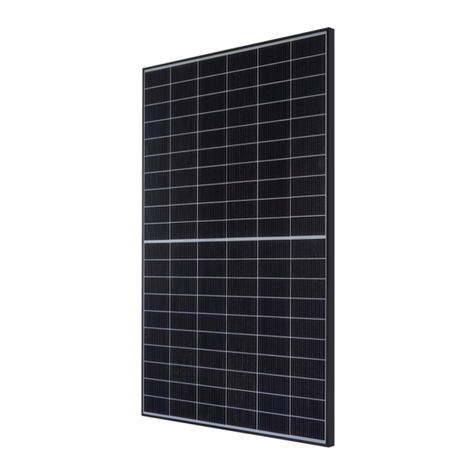
Panasonic
Panasonic EVERVOLT EVPV Series General installation manual
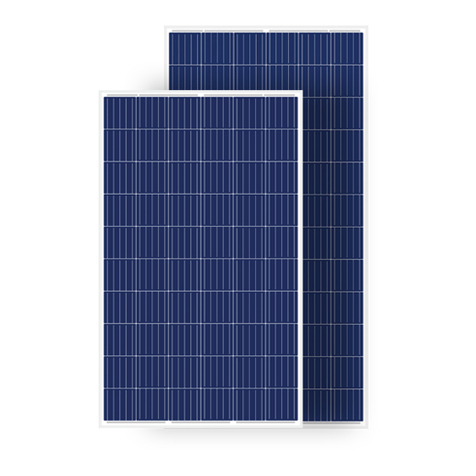
Jinergy
Jinergy JNMP60 series installation guide
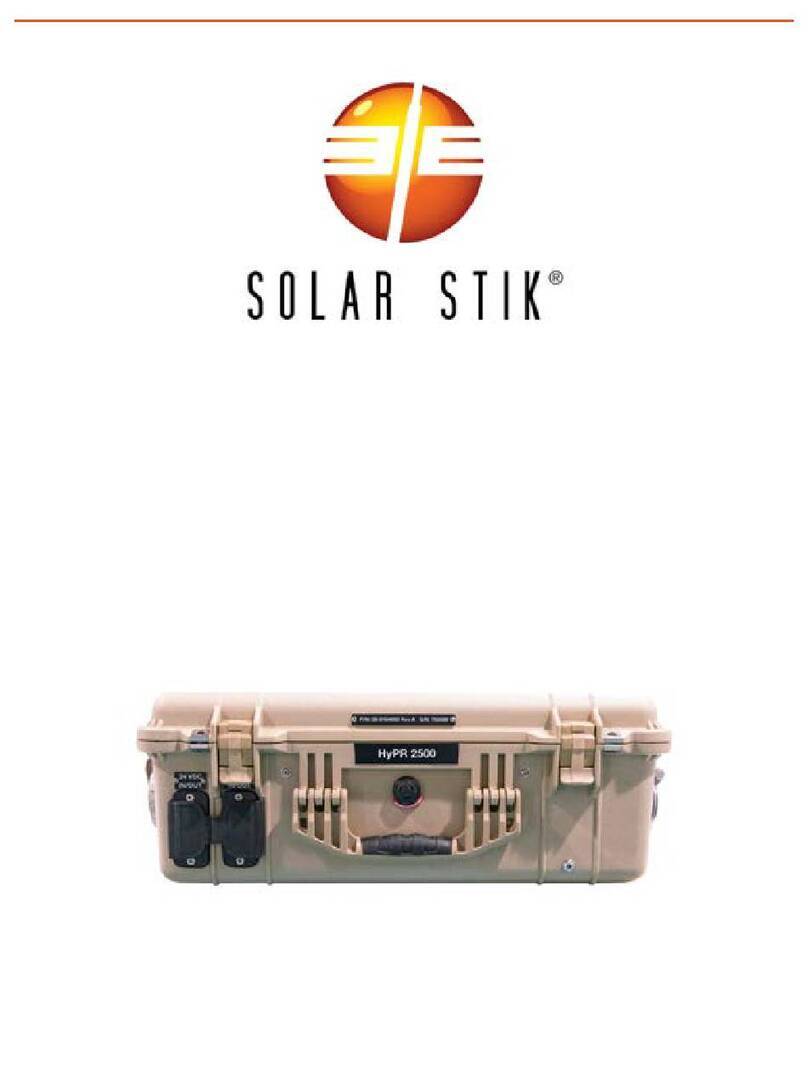
Solar Stik
Solar Stik 24VDC HyPR 3000 Operator and maintenance manual
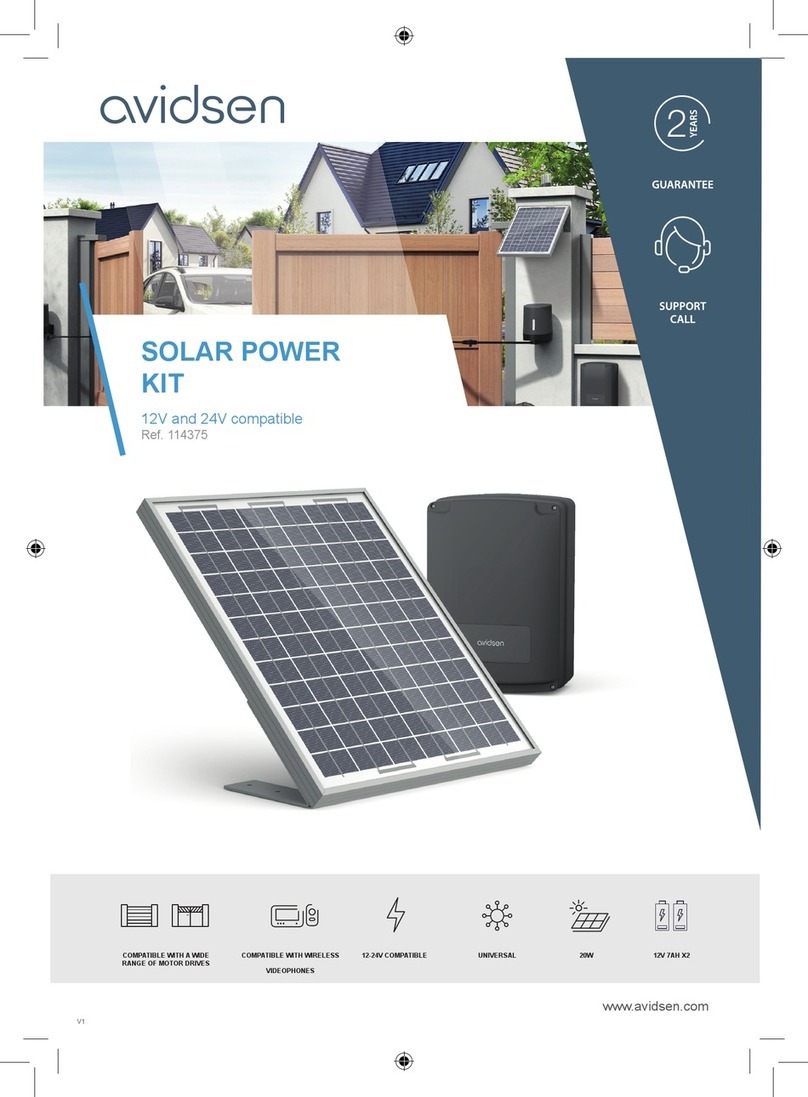
Avidsen
Avidsen 114375 manual
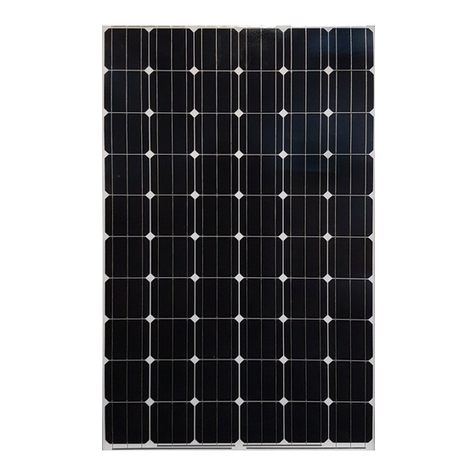
Astronergy
Astronergy CHSM6610M installation manual

Kyocera
Kyocera KC-120-1 installation manual

Sanyo
Sanyo HIT Power 205 HIP-205BA19 General installation manual

Viessmann
Viessmann VITOSOL 100-F SV Technical guide

Solarsol
Solarsol SSP27 user manual
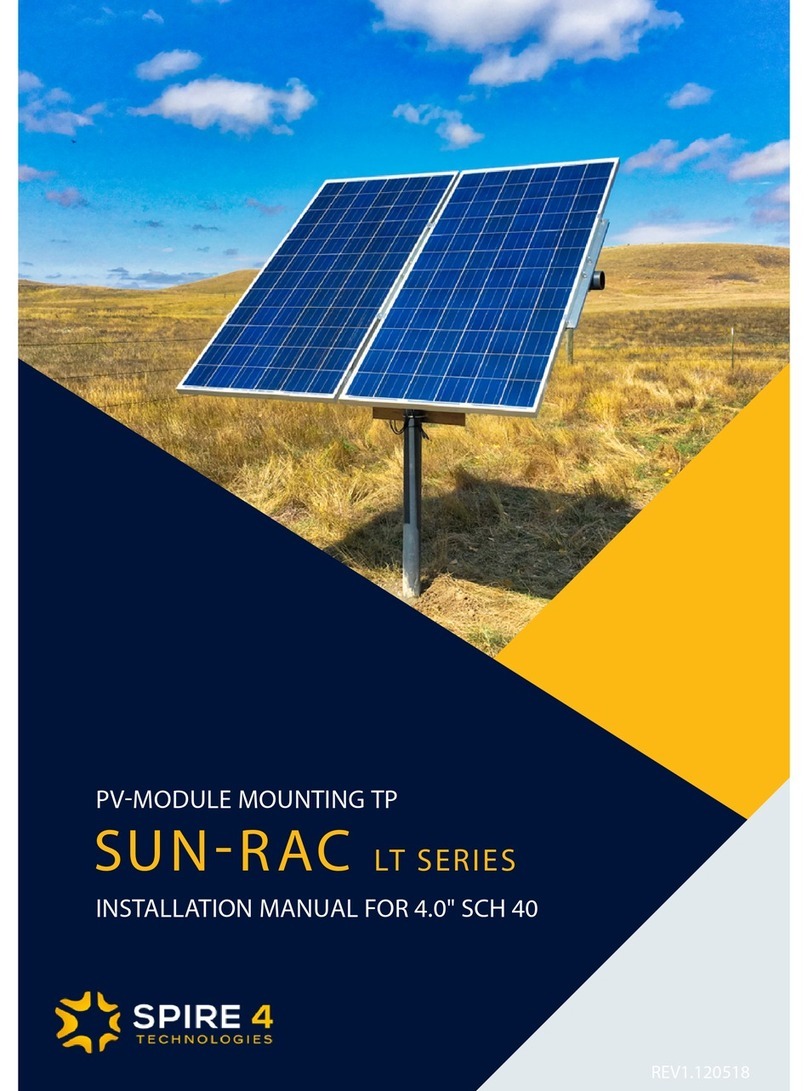
Spire 4 Technologies
Spire 4 Technologies SUN-RAC SRTP-PM-1 installation manual
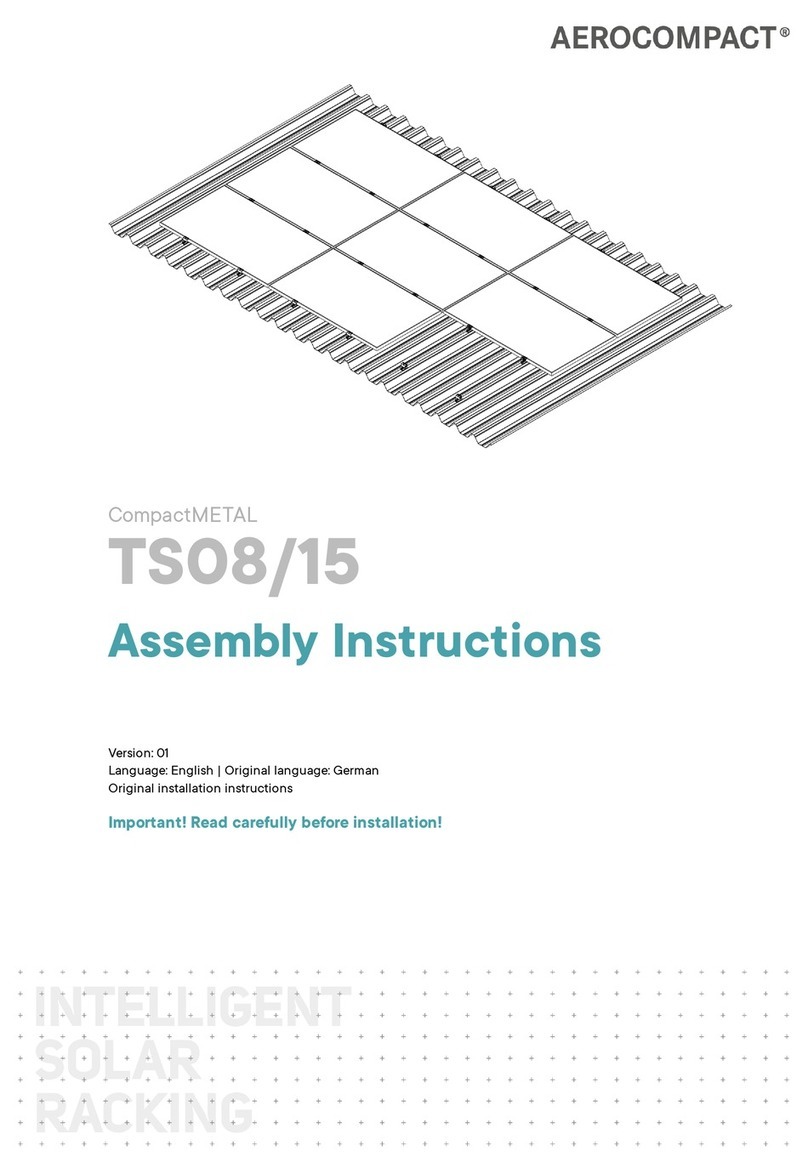
AEROCOMPACT
AEROCOMPACT CompactMETAL TS08 Assembly instructions

